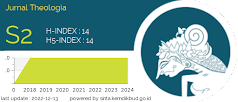RELASI CINTA DALAM TASAWUF
DOI:
https://doi.org/10.21580/teo.2013.24.2.333Abstract
Abstract: This article discusses the relationship of love in the Sufi perspective. Opositorum Coindencia theory is used to dissect this relationṢip , so that the devil Sufism is seen as a "sparring partner" in human spiritual quality improvement activities. This article shows that the Sufi tradition mainly in Waḥdah al-Wujūd, using imaginal thinking mindset see and understand the duality (bipolar), even though this diversity is unity of opposites. In the context of Sufi, masculinity—whichstated that the dominant sociological—declared substantially have "weaknesses." Because masculinity will not appear if there is no femininity. While in the context of the birth of the universe and the form of anything that is in fact born out of the urge of love that goes on this feminine category. In other words, masculinity will not be born if it is not driven by the feminine aspect. This is the "mystery of immense power" aspect of femininity in Sufi discourse. Thus, there is nothing more superiority between these two aspects. Relation is equal based on and effect of love. Abstrak: Artikel ini membahas tentang relasi cinta dalam perspektif Sufi. Teori Coindencia Opositorum dipakai untuk membedah relasi ini, sehingga dalam Sufisme setan dipandang sebagai “sparing partner” manusia dalam melakukan kegiatan peningkatan kualitas ruhani. Artikel ini menunjukkan bahwa tradisi sufi terutama dalam tasawuf waḥdat al-wujūd, dengan menggunakan pola pikir imaginal thinking melihat dan memahami dualitas (bipolar), bahkan keragaman sekalipun ini adalah unity of opposites. Dalam konteks sufi, maskulinitas—yang dinyatakan yang secara sosiologis dinyatakan dominan itu— secara substansial memiliki “kelemahan”. Karena maskulinitas tidak akan muncul jika tidak ada femininitas. Sementara dalam konteks lahirnya wujud semesta dan apapun yang ada justru lahir karena dorongan cinta yang masuk pada kategori feminin ini. Dengan kata lain, maskulinitas tidak akan lahir jika tidak didorong oleh aspek feminin. Inilah “misteri kekuatan dahsyat” aspek femininitas dalam wacana sufi. Dengan demikian, tidak ada yang lebih superioritas antara dua aspek ini.Relasinya adalah setara berdasar dan akibat dari cinta. Keywords: Waḥdah al-Wujūd, sufi, feminitas, maskulini¬tas, ḥubb.Downloads
References
Abū Faḍl, Maḥmūd al-Alūsī, Rūḥ al-Ma’ānī fī Tafsīr al-Qur’ān al-’Aẓīmwa Sab’u al-Maṡānī, Juz XIII, Bairut: Dār Iḥyā al-Turāṡ al-’Arābī, tth.
Adams, Daniel J., Cross Cultural Theology: Western Reflections in Asia, New York: John Knox Press, 1987.
Ann, Oakley, Sex, Gender, and Society, New York: Harper and Row, 1972.
Baldick, Julian, “The Legend of Rabi’ah of Baṣra: Christians Antecedents, Muslim Counterparts”, Religion20, 1990, h. 233-247.
Bukhārī, Ṣaḥīḥ Bukhārī, Jil. XXI, Mesir: Mauqi’ Wazārah wa al-Auqāf al-Miṣiriyah, t.th, h. 401.
Chittick, William C., "Sufi Thought and Practice”, The Oxford Encyclopedia of the Modern IslamicWorld, diedit oleh John L. Esposito, 4 volume , New York & Oxford: Oxford University Press, 1998.
Chittick, William C., Jalan Cinta Sang Sufi: Ajaran Spiritual Jalaluddin Rumi , Jogjakarta: Penerbit Qalam, 2003.
Chittick, William C., Jalan Sang Sufi, Jogjakarta: Pustaka Qalam, 2003.
Craig, Edward, Routledge Encyclopedia of Philosophy: Sociology of knowledge to Zaroastrianism, Routledge: Taylor & Francis, 1998.
Ernst, Carl W., Ajaran dan AmalanTasawuf, Jogjakarta: Pustaka Sufi, 2003.
Ghazālī, AbūḤāmid, Iḥyā ‘Ulūm al-Dīn, Juz III, dalam Maktab al-Syāmilah , CD Software.
http://en.wikipedia.org/wiki/Unity_of_opposites, Download, 25 Mei 2009.
Ibn ‘Arabī, al-Futuḥāt al-Makkiyah, Jil. II, Kairo: Dār al-Kutub al-‘Arābiyah al-Kubrā, 1329/1911.
Ibn ‘Arabī, Fuṣūṣ al-Ḥikam, diedit dan diberi komentar oleh Abū al-A‘lā ‘Afīfī, Vol. I, Beirut: Dār al-Kitāb al-‘Arābī, 1980.
Ibn ‘Arabī, Fuṣuṣ al-Ḥikam, diedit oleh Afīfī, Beirut: Dār al-Kutub al-‘Arabī, 1946.
Ibn ’Arabī, Kitāb al-Jalālah, dalam Rasāil Ibn al-Arabī, Part 2, Heydarabad-Deccan: The Dairat al-Ma‘ārif al-Osmania, 1948.
Imām Bukhārī, Muḥammad ibn Ismā‘īl Abū `Abd Allāh, Ṣaḥīḥ al-Bukhārī, Juz VI, Bairut: Dār Ibn Kaṡīr, 1987.
Imām Muslim, Abū al-Ḥusain Muslim bin al-Hajjaj al-Qusyairī al-Naisaburī, Ṣaḥīḥ Muslim, Juz IV, Beirut: Dār al-Turaṡ al-‘Arābī, tth.
Izutsu, Toshihiko, "Ishraqiyah," The Encyclopedia of Religion, diedit oleh Mircea Eliade, 16 volume, New York: Macmillan, 1987.
Kanafi, Imam, Metafiasika Sufi dan Relasi Gender: Sebuah Studi atas Pemikiran Suhrawardi Syaikhul Isyrāqiyah, Jakarta: SPs. UIN Jakarta, 2008.
Kāsyānī, Abd al-Razzāq, Ta’wīlāt, Juz I, Beirut: Dār Yaqẓat al-Adabiyat, 1968.
Murata, Sachiko, The Tao of Islam, terj. Rahmani Astuti, Bandung: Mizan, 1996.
Rūmī, Jalāl al-Dīn, Mathnawi, Jilid II, Syair nomor 970-974.
Sakandarī, Ibn ‘Aṭā Allāh, Miftāḥ al-Falāḥ wa Miṣbāḥ al-Arwāḥ, Mesir: Maṭba‘ah Muṣṭafā al-Bābī al-Ḥalabī wa Aulāduh, 1961.
Sell, Michael A., Sufisme Klasik, Bandung: Mimbar Pustaka, 2003.
Suyūthī, Jalāl al-Dīn, Jam‘u al-Aḥādiṡ, Jil. II dalam Maktabah Syāmilah , CD.
Suyūṭī, Jalāl al-Dīn, Jam’u al-Jawāmi’ aw al-Jāmi` al-Kabīr li al-Suyūṭī, Juz I, tt: tp, tth.
Ṭabranī, Mu’jam al-Kabīr. Juz XI , tt: tp, tth.





















